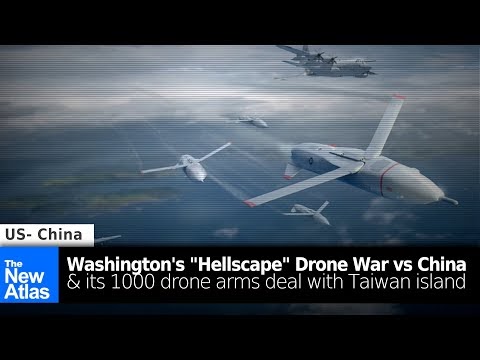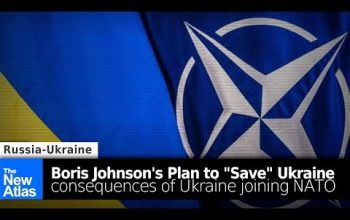June 24, 2024 (NEO – Brian Berletic) – The Washington Post in an opinion piece by Josh Rogin titled, “The U.S. military plans a ‘Hellscape’ to deter China from attacking Taiwan,” lays out a fundamentally flawed assessment of a US Department of Defense strategy relying on unmanned systems to fight off the Chinese military for up to a “month” before the US and its allies can mobilize their armed forces.
And even as the Washington Post attempts to sell this strategy as plausible, it itself calls into question the window of opportunity in which it could be implemented and actually succeed.
A Flawed Strategy Laid Upon an Equally Flawed Premise
Before even examining the flaws of the strategy itself, it must first be pointed out that the entire premise upon which this strategy would be utilized, “defending Taiwan,” is entirely flawed.
The US State Department, upon its own official website under a section titled, “U.S. Relations With Taiwan,” unambiguously admits, “we do not support Taiwan independence.”
If the US government does not recognize or support Taiwan independence, by implication Taiwan is a “dependent” of another state. According to the United States’ own “One China” policy laid out in the 1972 Shanghai Communique, that state is China, whose sole legitimate government is the People’s Republic of China (PRC).
The 1972 document explains in detail:
The United States acknowledges that all Chinese on either side of the Taiwan Strait maintain there is but one China and that Taiwan is a part of China. The United States Government does not challenge that position.
Thus, any interaction between Taiwan and the rest of China is a matter of Chinese internal political affairs, amid which the US has no ability to interfere in accordance with international law and more specifically, under the UN Charter and its guarantee of a nation’s territorial integrity and political independence.
The UN Charter says unequivocally:
All Members shall refrain in their international relations from the threat or use of force against the territorial integrity or political independence of any state, or in any other manner inconsistent with the Purposes of the United Nations.
Quite clearly Washington’s unofficial support for separatism in Taiwan, in contradiction of its own agreements with Beijing regarding the status of the island province, is a violation of international law to begin with. Any plans by the US to use any kind of military force, including unmanned systems, to intervene in China’s internal political affairs, begins from an entirely flawed, indefensible position under international law.
Why a Drone “Hellscape” Will Not Work
China has a multitude of ways to deal with US-sponsored separatism and other violations of Chinese sovereignty over the island province of Taiwan beyond an amphibious invasion US military planners envision their drone armies fighting against and winning.
Despite Washington’s political capture of Taiwan’s local administration, the island’s economy is heavily dependent on the rest of China. Nearly half of all exports from industry located on the island is exported to the rest of China. Imports from the rest of China are also essential, including raw materials required for the island’s extensive semiconductor and electrical component industries.
By simply cutting trade, Taiwan would cease to function as a viable economic entity. Combined with a blockade enforced by Chinese military aviation, submarine forces, and its own large drone capabilities, Washington’s “hellscape” strategy of employing drones to stop an invasion that never comes is rendered moot.
But what if Chinese military forces engaged with US drone capabilities in and around the Chinese island province of Taiwan?
The Washington Post op-ed claims:
There are some public signs the Hellscape plan is making progress. In March, the Defense Department announced it would spend $1 billion on a program called “Replicator” to build swarms of unmanned surface ships and aerial drones for this very mission. Paparo said the Replicator program shows that the United States is also learning lessons from the Russia-Ukraine war, where Ukraine has innovated with drone technology.
The timeline for delivery of these systems is unclear. If the drone swarms aren’t ready when the attack comes, that could raise the prospects of a protracted conflict that would incur heavy losses for U.S. Naval and Air Force assets and would likely expand to include allies such as Japan, South Korea and the Philippines, according to most war game exercises conducted at U.S. think tanks.
This is after the Washington Post cited US Navy Admiral Samuel Paparo, “the new head of U.S. Indo-Pacific Command,” who refused to provide details of the plan, but claimed, “it’s real, and it’s deliverable.”
The Washington Post citing Ukraine was particularly ironic, considering the drones sent to Ukraine by the United States and its allies have failed to produce results. This includes an array of larger, longer-range strike drones like Turkiye’s Bayraktar TB-2 drone, but also smaller kamikaze drones like the US-manufactured Switchblade.
The drones Ukraine has utilized most effectively have either been bought from China, or are made from parts sourced in China.
In a rebuttal to Washington’s “hellscape” plan published by Chinese state Global Times, Hu Xijin points out a number of very obvious, but apparently omitted factors by the Western media promoting the strategy.
Hu Xijin points out that China is capable of manufacturing more drones, for cheaper, faster, and with better capabilities than the United States. Considering the reality on the ground in Ukraine where the little success Ukrainian forces have had in drone warfare is owed not to drones developed by US arms manufacturers, but Chinese-made drones modified by Ukrainians for military purposes, Hu Xijin’s conclusions are far from bluster.
Another factor omitted among US talk of war with China in and around the island province of Taiwan is the distance the US must travel to show up on the battlefield in the first place. Separated by the Pacific Ocean, the US must travel thousands of miles to reach the Taiwan Strait and surrounding areas.
While the US maintains a network of military bases across South Korea, Japan, and now the Philippines, the US must still supply these bases from US territory and US forces must still travel hundreds of miles to reach the Taiwan strait, whereas Chinese forces are already there because it is China.
Fighting any sort of war against a nation with a larger population, larger industrial base, a larger military industrial production capacity, and a comparable military force, and doing so right off the coast of that nation, just like the idea of “defending Taiwan” from China while officially recognizing Taiwan as part of China, is entirely irrational and doomed to fail before any such conflict even begins.
There is no doubt regarding the US military’s capacity to create death and destruction. However, its ability to find victory amid the swath of chaos it has cut around the globe is very doubtful. The US in many ways has many more advantages amid its proxy war with Russia in Ukraine than it would be fighting China right off China’s own coast, and yet it is a proxy war the US and its allies are still losing.
It is difficult to assess the capabilities behind Washington’s “hellscape” strategy, considering no part of it has been made public and considering how poorly the US military has performed in recent years elsewhere around the globe. It could be that US military weakness has forced Washington to resort to a “blowfish” strategy, inflating itself to convince an adversary it is much larger and more powerful than it actually is. A blowfish also employs spines and toxins to serve as further deterrence. However, in nature, many species have evolved to see past the blowfish’s deception and work past its spines and toxins to make an easy meal of it.
China too is likely capable of seeing through Washington’s bluff, and working past the “thorny spines and toxins” Washington is using to convince Beijing upholding its sovereignty over Taiwan isn’t worth the trouble.
It must also be remembered that Washington’s goal isn’t actually to “defend” Taiwan, it is to raise the cost as high as possible for its inevitable full reunification with the rest of China. The island province being irreversibly destroyed amid the fighting suits Washington much more than sizable percentages of its population, industry, and infrastructure finally and fully joining with the rest of China.
The US government and arms industry-funded think tank, the Center for Strategic and International Studies, in a January 2023 paper titled, “The First Battle of the Next War: Wargaming a Chinese Invasion of Taiwan,” would admit after wargaming a possible conflict between China and the US over the island province of Taiwan that:
The U.S. and Taiwanese success in frustrating the Chinese invasion is tempered by the extensive damage done to the Taiwanese infrastructure and economy.
This, it should be noted, was CSIS’ best-case scenario. It is perhaps this final point that those in Taiwan itself should consider most.
China is clearly prepared to pay any price to preserve its sovereignty and territorial integrity. Washington has repeatedly demonstrated it is fully prepared to completely expend its proxies for its own benefit. Those on Taiwan must see the real and only decision they have, either reunification or annihilation, and annihilation deliberately engineered by and for the US, not by Chinese policymakers, but instead to spite them.
Brian Berletic is a Bangkok-based geopolitical researcher and writer, especially for the online magazine “New Eastern Outlook”.



